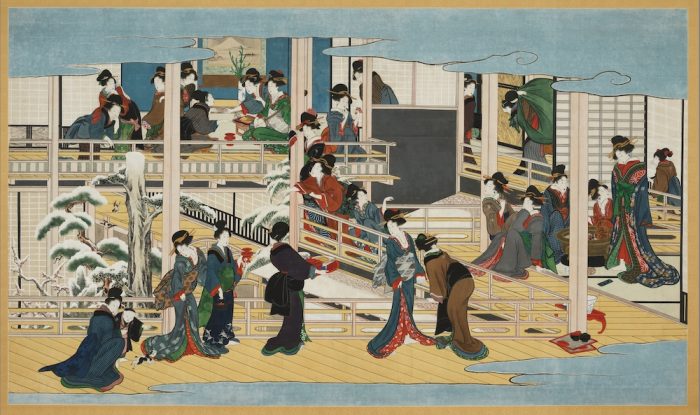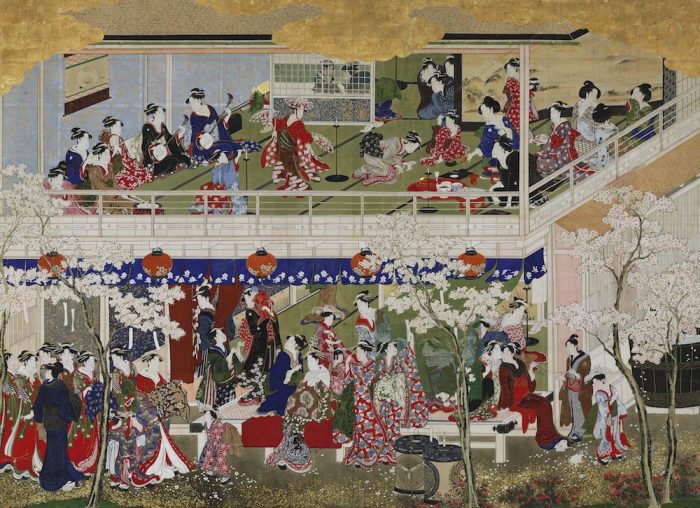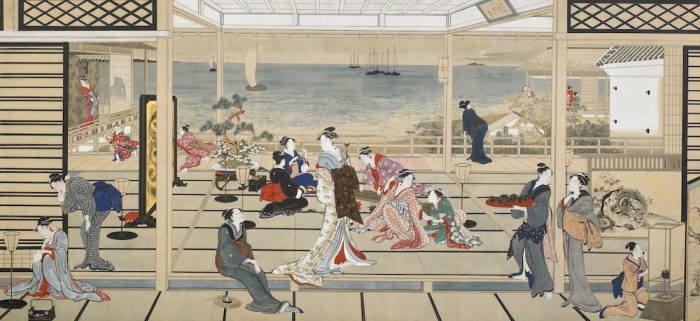The Freer Sackler celebrates the National Cherry Blossom Festival with an unprecedented Japanese exhibition.

Snow at Fukagawa, Kitagawa Utamaro (1753–1806) Japan, Edo period, ca. 1802–6 Hanging scroll; color on paper, Okada Museum of Art, Hakone, Japan.
Kitagawa Utamaro’s elusive triptych is reunited at the Arthur M. Sackler Gallery for the first time in over 100 years.
Due to loan restrictions stipulated by Charles Lang Freer in his will, this is the only time viewers will have the chance to see Cherry Blossoms at Yoshiwara, Snow at Fukagawa, and the Freer’s own Moon at Shinagawa side by side as they were originally imagined. This comprehensive experience is a result of the recent rediscovery of Snow at Fukagawa, 1802-6 in Japan in 2014. The painting had been lost for several decades.

Cherry Blossoms at Yoshiwara, Kitagawa Utamaro (1753–1806) Japan, Edo period, ca. 1793. Painting mounted on panel; color on paper Wadsworth Atheneum Museum of Art Hartford, Connecticut. The Ella Gallup Sumner and Mary Catlin Sumner Collection Fund, 1957.
17.
The theme of a relationship to nature is what unites these works each of which features a different backdrop of a pleasure house in Edo (now Tokyo). The different styles of the works suggest they were painted over a period of at least a dozen years. The three paintings traveled to Paris together in the 1880s and were quickly sold to different buyers.
Interestingly the large triptych panels are not signed; however when compared with the rest of the drawings, prints, and paintings in the exhibition it is clear they came from Utamaro’s hand. Cherry Blossoms at Yoshiwara, 1793 shows the communities cherry blossom festival, one of the most important annual events. Moon at Shinagawa, 1788 was purchased by Charles Lang Freer in 1903, is a depiction of Tokaido, the first post station on the road from Edo to Kyoto. It was a popular place to seek pleasurable encounters.

Moon at Shinagawa (also known as Moonlight Revelry at Doz? Salami), Kitagawa Utamaro (1753–1806) Japan, Edo period, ca. 1788. Painting mounted on panel; color on paper Freer Gallery of Art Gift of Charles Lang Freer, F1903.54.
Little is known about the life of Utamaro but his legacy is defined by his portrayal of the Japanese pleasure districts. He was essential in defining a style known as japonisme which commanded the attention of 19th and 20th century collectors. Utamaro was a ladies man. Scholars of his work suggest he actively took part in the scenes of pleasure he depicted, earning the reputation of a “Don Juan” in the minds of French collectors.
The new scholarship offered by Julie Nelson Davis, guest curator and Utamaro expert, suggests that Utamaro’s persona as a ladies man was a heavily constructed one. Branded predominately by his art dealer Hayashi Tadamasa, Utamaro is one of the first examples of an artist who adopted an effected persona to sell more work. During his career Utamaro created at least two thousand designs that were reproduced by the thousands as printed products.
The depiction of teenage courtesans as a genteel cohort of accommodating women is a prevalent theme in the exhibition and a little disconcerting. However, it is a testament to the interest in the exotic and rich history of Japan which appeared to be a pristine utopia. This comforted westerners during a time in which vast world expansion overwhelmed the psyche.
Inventing Utamaro: A Japanese Masterpiece Rediscovered is on view at the Arthur M. Sackler gallery through July 9.




